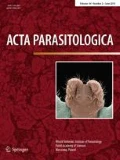Abstract
Purpose
Nothing is known about the coccidian parasites of vagrant shrews, Sorex vagrans Baird, 1868. Here we report, for the first time, the occurrence of Eimeria longirostris Hertel and Duszynski, 1987 from faecal contents of S. vagrans from Montana, USA.
Methods
Faecal samples, collected in July and August 2020 from six pitfall-trapped vagrant shrews as well as faeces from two masked shrews, Sorex cinereus Kerr, 1792, and one American pygmy shrew, Sorex hoyi Baird, 1857 from Missoula County, Montana, USA, were examined for coccidian parasites. Samples were placed in individual vials containing aqueous potassium dichromate. They were examined for coccidia after flotation in Sheather’s sugar solution, measured, and photographed.
Results
Three (50%) S. vagrans and one (50%) S. cinereus were found to be passing oocysts of Eimeria longirostris Hertel and Duszynski, 1987; the single S. hoyi was negative. Oocysts from S. vagrans were subspheroidal and measured (average L × W) 16.1 × 14.4 µm with an L/W ratio of 1.1. One (typically) to two polar granules was present but a micropyle and oocyst residuum were absent. Sporocysts were ovoidal and measured 9.6 × 6.2 µm with an L/W ratio of 1.6. A Stieda body was present but subStieda and paraStieda bodies were absent. The sporocyst residuum was composed of various sized granules typically scattered between and across the sporozoites but sometimes formed a loose aggregate or compact mass.
Conclusion
We document a new host and new geographic record for E. longirostris from S. vagrans and report the coccidian from S. cinereus for the third time but the first report from specimens from Montana. This coccidian has now been reported from at least 12 species of shrews within the genus Sorex in 14 US states and two provinces in Canada.

References
American Society of Mammalogists (ASM) (2020) Mammal species list search. http://www.mammalogy.org/mammals-list/?start=10. Accessed 4 Oct 2020
Barnard WP, Ernst JV, Stevens RO (1971) Eimeria palustris sp. n. and Isospora hammondi sp. n. (Coccidia: Eimeridae) from the marsh rice rat, Oryzomys palustris (Harlan). J Parasitol 57:1293–1296. https://doi.org/10.2307/3277983
Duszynski DW, Eckerlin RP, McCarthy TJ (2003) Eimeria species from Cryptotis shrews (Insectivora: Soricidae) with description of a new species. J Parasitol 89:974–977. https://doi.org/10.1645/ge-3135
Duszynski DW, Upton SJ (2000) Coccidia (Apicomplexa: Eimeriidae) of the mammalian order Insectivora. Spec Publ Mus Southwest Biol 4:1–67
Gillihan SW, Foresman KR (2004) Sorex vagrans. Mamm Spec 744:1–5. https://doi.org/10.1644/1545-1410(2004)744%3c0001:SV%3e2.0.CO;2
Hertel LA, Duszynski DW (1987) Coccidian parasites (Apicomplexa: Eimeriidae) from insectivores. III. Seven new species from shrews (Soricidae: Soricinae) from Canada, Japan, and the United States. J Parasitol 73:172–183. https://doi.org/10.2307/3282363
Hertel LA, Duszynski DW (1987) Corrigendum: revision of the name Eimeria palustris Hertel & Duszynski, 1987, from shrews (Sorex spp.). J Parasitol 73:1288. https://doi.org/10.2307/3282334
Lynch AJ, Duszynski DW (2008) Species of coccidia (Apicomplexa: Eimeriidae) in shrews from Alaska, U.S.A., and northeastern Siberia, Russia, with description of two new species. J Parasitol 94:881–888. https://doi.org/10.1645/ge-1506.1
McAllister CT, Seville RS (2017) A new eimerian (Apicomplexa: Eimeriidae) from southern short-tailed shrews, Blarina carolinensis (Bachman) (Soricomorpha: Soricidae: Soricinae) from southeastern Oklahoma, USA. Syst Parasitol 94:711–716. https://doi.org/10.1007/s11230-017-9730-8
Milek J, Seville RS (2003) Species of Eimeria and Isospora (Apicomplexa: Eimeriidae) from shrews (Insectivora: Soricidae) from the Greater Yellowstone Area, Wyoming, U.S.A. Comparative Parasitol 70:72–77. https://doi.org/10.1654/1525-2647(2003)070[0072:soeaia]2.0.co;2
Nagorsen DW (1996) Opossums, shrews and moles of British Columbia. UBC Press, Vancouver, British Columbia, p 169
Smith HC (1988) The wandering shrew, Sorex vagrans, in Alberta. Can Field Nat 102:254–256
Wilber PG, Duszynski DW, Upton SJ, Seville RS, Corliss JO (1998) A revision of the taxonomy and nomenclature of the Eimeria spp. (Apicomplexa: Eimeriidae) from rodents in the Tribe Marmotini (Sciuridae). Syst Parasitol 39:113–135. https://doi.org/10.1023/A:1005914010087
Wilson DE, Reeder DM (eds) (2005) Mammal species of the world: a taxonomic and geographic reference, vol 2, 3rd edn. Johns Hopkins University Press, Baltimore, p 142
Acknowledgements
We thank Drs. Scott L. Gardner and Gábor R. Rácz (HWML) for expert curatorial assistance and Russell S. Pfau (Tarleton State University, Stephenville, Texas) for confirming the identity of our hosts via molecular sequencing.
Author information
Authors and Affiliations
Corresponding author
Ethics declarations
Conflict of Interest
The authors declare that they have no conflict of interest.
Ethical Approval
Ethical approval for shrew trapping was not required according to the Montana Fish, Wildlife & Parks. This study followed: Sikes RS, Gannon WL (2011) Guidelines of the American Society of Mammalogists for the use of wild mammals in research. J Mamm 92:235–253.
Additional information
Publisher's Note
Springer Nature remains neutral with regard to jurisdictional claims in published maps and institutional affiliations.
Rights and permissions
About this article
Cite this article
McAllister, C.T., Hnida, J.A. & Kinsella, J.M. Eimeria longirostris (Apicomplexa: Eimeriidae) from Vagrant Shrew, Sorex vagrans (Mammalia: Eulipotyphla: Soricidae), from Montana, USA. Acta Parasit. 66, 710–713 (2021). https://doi.org/10.1007/s11686-020-00321-z
Received:
Accepted:
Published:
Issue Date:
DOI: https://doi.org/10.1007/s11686-020-00321-z

